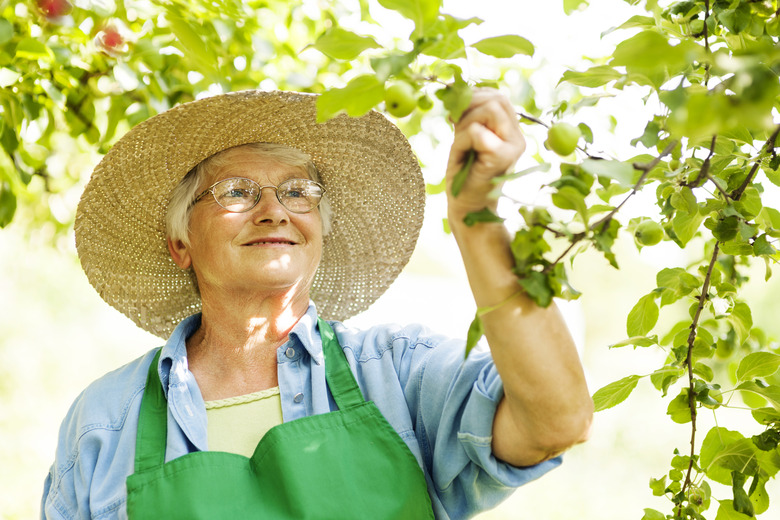How To Know When To Pick Apples
The ideal time to pick cultivated apples (Malus domestica) is when they're mature, but not necessarily totally ripe. Although most apples thrive in U.S. Department of Agriculture plant hardiness zones 5 through 7, some cultivars grow in USDA zones 2 through 4 or USDA zones 8 through 10. The climate is an important factor in the ripening of apples, but hands-on methods are best for knowing when to pick them.
Mature Versus Ripe
Apples that have reached the stage of maturity will continue to ripen after you pick them as the starch turns to sugar. Totally ripe apples deteriorate quickly. Unless you want to eat the apples immediately, pick them when they are mature but not overly ripe.
Warm temperatures speed up the ripening process, but cold retards it. You can keep apples at 40 degrees Fahrenheit for approximately six months, according to the University of Nebraska at Lincoln Extension.
General Factors
The season for picking apples typically ranges from summer to late fall. Overall, apples mature earlier in warmer zones than in cooler ones, but different cultivars reach maturity at different times. Even the location of the planted tree can determine when apples are ripe. Apples receiving more sun on the southern side of the tree will ripen quicker than apples located on portions of the tree receiving less sun.
University extensions in your area can provide a general calendar, but the best time for picking a particular cultivar is different every year because of variations in precipitation, sun and heat.
Check the Color
One method of judging whether apples are ready to pick is by skin color. Depending on the type of apple, the skin starts out green and then turns to a mature color of mostly red or yellow. In McIntosh apples (Malus domestica "McIntosh") and hardy in USDA zones 4 through 7, the color around the stem lightens and then turns yellow when the apples are mature. Fruits are generally ripe and ready for harvesting during late summer. Some all-red apples are highly red weeks before they mature, so flesh color is a better indicator for these apples.
**When apples are mature, the color of the flesh inside becomes white or yellow.** The outside of the apple seed also becomes dark brown when most apples are mature.
Squeeze, Sniff and Taste
An apple that's not ready to pick is hard when you hold it in your hand and squeeze it, while a mature apple is firm but not overly soft. **A soft, mushy apple is already past its prime.** A mature apple develops a sweet smell because the sugar content has increased. It's also crisp and juicy and tastes sweet, not sour.
Try Picking Them
**When a few good apples have dropped on their own, the fruit is nearly ready to pick.** Test their readiness by seeing how easily you can separate the apples from the branch. Using an upward, twisting technique, try to pick a few. If they're mature, they should come away easily. This method won't work if you've applied a spray to stop the fruit from dropping.
